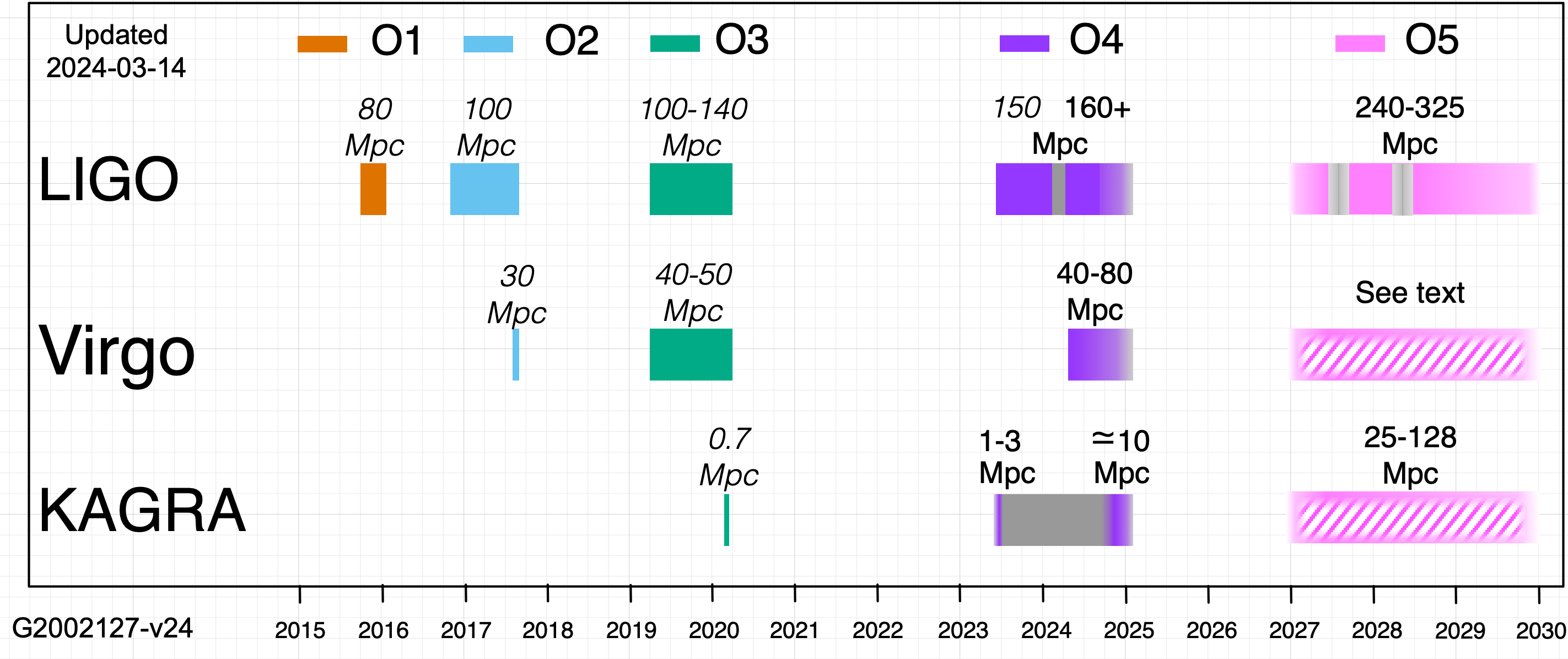LIGO, VIRGO AND KAGRA OBSERVING RUN PLANS¶
(10 April 2024 update; next update 15 May 2024 or sooner)
O4b: The LIGO Hanford (LHO), LIGO Livingston (LLO), and Virgo detectors transitioned to the regular observing run O4b at 15:00 UTC on 10 April 2024. O4b will run until February 2025 (specific date TBD), with no further planned breaks in observing.
The first period of the O4 observing run, O4a, started at 15:00 UTC 24 May 2023, and ended at 16:00 UTC 16 January 2024 for a period of commissioning between O4a and O4b.
The two LIGO detectors are now running with a sensitivity of 155-175 Mpc, and with duty cycles in recent days of 80-98%. There will be further minor adjustments to optimize the performance during the O4b observing period.
The Virgo detector is running with a sensitivity of 55-60 Mpc and is targeting a duty cycle of at least 80% for O4b. There will be further limited adjustments during the run, to improve its performance. At the moment, Virgo is reconsidering its plans for O5 and both the date on which we will be able to enter O5 and the target sensitivity are currently unclear. We expect to be able to define our plans for O5 in the second half of 2024.
On January 1st, 2024, a 7.6 magnitude earthquake struck near the KAGRA site, marking the most significant seismic tremor in the area of the KAGRA site in the past century. Among the nine mirror suspensions, three IMC mirror suspensions were recovered, and the IMC performance check is ongoing. We hope to finish other recovery works as soon as possible and restart commissioning, then join O4b before the end of O4 with a BNS range of around 10 Mpc.
As discussed last fall, the LIGO-Virgo-KAGRA Collaboration (LVK) is migrating all of the OpenLVEM content and future communications related to multi-messenger astronomy to the OpenMMA Forum hosted by SCiMMA (https://scimma.org/). All subscribers to the OpenLVEM mailing list have been migrated to the OpenMMA list.
Please check the OpenLVKEM pages for the timing and coordinates for telemeetings. The schedule of calls is posted at the OpenLVKEM wiki (see below), along with Agenda and pointers to materials.
For more information, see:
OpenMMA wiki - https://github.com/scimma/openMMA/wiki IGWN public alert user guide - https://emfollow.docs.ligo.org/userguide/
Timeline¶
The gravitational-wave observing schedule is divided into Observing Runs, down time for construction and commissioning, and transitional Engineering Runs between commissioning and observing runs. The current best understanding of the long-term observing schedule is shown below (or https://dcc.ligo.org/LIGO-G2002127/public). Since BNS (Binary Neutron Star) mergers are a well-studied class of gravitational-wave signals, this figure gives the BNS range for for a single-detector SNR threshold of 8 in each observing run.

The O5 start dates, duration, and sensitivities are current best guesses, and will likely be adjusted as we approach that run for all the detectors (see text).
Live Status¶
A public web page that report live status of the LIGO/Virgo detectors and alert infrastructure is at
- Detector Status Portal: Daily summary of detector performance.